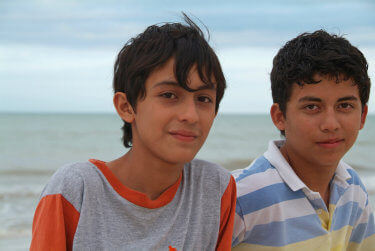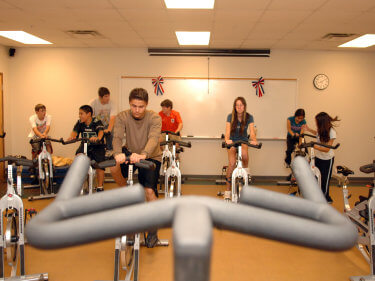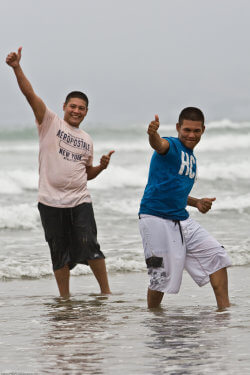A major concern in education today is the negative impact of stereotype thinking. The physical education classroom has its own social dynamic. But unlike in other academic settings, physical education settings can, from the outset, be especially intimidating for some students. These students, who I’m going to refer to as the “Outgroup,” share many common characteristics that experienced teachers will immediately recognize.
Outgroup members sometimes appear slow, weak, overweight or obese, awkward or uncoordinated. These students often lack confidence and don’t have many class friends. Students who shy away from the ball or who stay on the periphery when games are being played fit this picture. If our profession hopes to succeed with 50 Million Strong by 2029 (50MS), these students or more appropriately this Outgroup is a group that our profession must intentionally target. If we fail to engage this group a significant proportion of our student population will never realize the health benefits of physical activity envisioned in 50MS.

According to SHAPE America’s website 50MS embraces “A commitment to put all children on the path to health and physical literacy through effective health and physical education programs.” (2016). To succeed there are at least three key components students clearly need: skills, knowledge and disposition. Without these, the goal of 50MS will not be reached. Unfortunately, absent effective interventions to help them feel comfortable in our physical education settings, the Outgroup students identified above are unlikely to possess the skills, knowledge or dispositions to lead healthy and physically active lives.
Daniel Kahneman (2001) has suggested that all of us have a propensity for what he labels “thinking fast and slow.” Dedicated parts of our brains exist that allow us to think quick for fast decisions (e.g. dodging objects/dangers), or think slow when deliberating problems (e.g. weighing pros and cons of processes). Kahneman points out that problems arise when we use the fast process to address issues better suited for slower process such as making value judgements about others.

As teachers, when we attempt to instruct a group of students it’s easy to overlook the true complexity of the challenges we face. We start out committed to furthering our instructional goals by teaching the appropriate outcomes of the day. But we often forget that every day our students are experiencing a myriad of different life experiences, some positive but many negative. Students may be excited, tired, frustrated or depressed. Many are going through puberty. Some may be menstruating. Others may be sick, hungry, or abused. All of these influences, unpredictable and unknown to the teacher, collectively complicate our teaching effectiveness and the extent to which our students are ready to learn.
Not surprisingly under such stressful conditions, it’s little wonder that teachers sometimes don’t think slowly or deliberately enough when Outgroup members don’t appear engaged or up-to-speed with the day’s lesson. It’s far easier, more satisfying, and more common for teachers to quickly and unconsciously direct their limited time and attention to students who are more engaged and seem more interested in grasping the instructional topic. This observation is not intended to criticize a teaching failure, but rather to explain why Outgroup students commonly get ignored in physical education.

A second teaching challenge related to the negative consequences of stereotyping is implicit bias: “Attitudes or stereotypes toward others that affect our understanding, actions, and decisions in an unconscious manner” (Kirwan Institute, 2017). Mahzarin and Greenwald (2013) developed an assessment of implicit bias that is known as the Implicit Association Test (IAT). This test identifies an individual’s bias toward a group of minorities (e.g. Blacks vs Whites, Gay vs Straight, Obese vs Skinny, etc.). What’s important to realize is that holding a bias does not imply someone is “bad,” “cruel,” or in some way not a good person. But recognizing the existence of implicit bias can help guide all of us who teach toward positive behavioral changes.
If you’re interested, Project Implicit offers a web site where you can take an implicit bias assessment. You will learn if perhaps you hold an implicit bias toward the obese or some other Outgroup. But remember, the goal of learning this about yourself is to help you identify a characteristic that you may hold so that you can intentionally augment your behavior/instruction toward that frequently outgrouped population. By reducing biased behaviors, teachers can help begin to integrate this population “back” into their classes and chip away at the task of creating a positive physical activity disposition in all students.
It might be instructive here to identify which group we would “all like to be a part of,” so I’ll share the theory of Intergroup/Ingroup vs Outgroup settings. Hewstone’s (2002) meta-analysis of multiple studies on in-group vs. out-group bias showed that there are many challenges related to this natural process of being outgrouped. Disenfranchisement, lack of buy-in, and continued low participation are a few of the behaviors related to the challenges experienced by outgrouped populations. I’m guessing that you may recognize these behaviors in this population in your setting. If so, take note, consider the distinct possibility that your classroom environment directly creates or at least contributes to these behaviors and consider making modifications.

I would like to solidify this point by directing folks toward the work of Claude Steele and his book Whistling Vivaldi: How Stereotypes Affect Us and What We Can Do (2011). As indicated by the title, this book alerts us to stereotype threat and the dangers we face each day buying into or perpetrating them. Teachers can help themselves avoid these traps with a pinch of self-reflection and an ounce of prevention. Consider this practice highlighted in SHAPE America’s Appropriate-and-Inappropriate-Uses-of-Fitness-Testing (2017), “The teacher highlights and celebrates intrinsic motivation, focusing on developing the skills, knowledge and dispositions necessary to be physically active. Teacher also publicly recognizes student effort that is within reach for all students.” This type of positive feedback provides an opportunity to “catch students doing the right thing” and recognizes behaviors (not results) that can lead to healthy lifestyles and succeeding with 50MS.
Finally, I would like to identify a third key component in the challenge of reaching historically outgrouped students in your PE class: Self-Determination Theory (Deci & Ryan, 2002). This, in a nut shell, is the inherent drive of an individual to be autonomous, highly skilled and connected to their society. Deci and Ryan’s work reveals that our natural desire to be proficient and part of a group is as strong as that of the desire to eat, drink or copulate. Teachers need to understand that no Outgroup members “want” to be outgrouped, but rather they find themselves in that situation by virtue of the behavior of their peers and sometimes their teachers. All teachers should intentionally plan to work with this outgrouped population to help them realize these basic needs.

In summary, I’m hopeful that physical educators will think more about the harmful effects of stereotyping their students, and begin discussing deliberate actions to minimize or reverse this trend. Neglecting to do so will unfortunately result in these historically outgrouped populations not acquiring the knowledge, skills and disposition necessary to be consistently physically active adults, and ultimately make it impossible for us to achieve our commitment to realizing 50 Million Strong by 2029.
References
SHAPE America – Society of Health and Physical Educators. 2016. Available at https://50million.shapeamerica.org/about-us/
Kahneman, D. (2011). Thinking, Fast and Slow. New York: Farrar, Straus and Giroux
Banaji, M.R., & Greenwald, A.G. (2013). Blind Spot: Hidden Biases of Good People. New York: Penguin Random House.
Deci, E.L., & Ryan R. (2002). Handbook on Self-determination Research: Theoretical and Applied Issues. Rochester, NY: University of Rochester.
Hewstone, M., Rubin, M., & Willis, H. (2002) Intergroup Bias, Annual Review Psychology 2002. 53:575–604.
Kirwan Institute (2017). Retrieved from http://kirwaninstitute.osu.edu/
Steele, C. (2011).Whistling Vivaldi: How Stereotypes Affect Us and What We Can Do. New York: W.W. Norton.
SHAPE America – Society of Health and Physical Educators. 2017. Appropriate-and-Inappropriate-Uses-of-Fitness-Testing. Available at https://www.shapeamerica.org/advocacy/positionstatements/pe/upload/Appropriate-and-Inappropriate-Uses-of-Fitness-Testing-FINAL-3-6-17.pdf

Excellent and timely article.